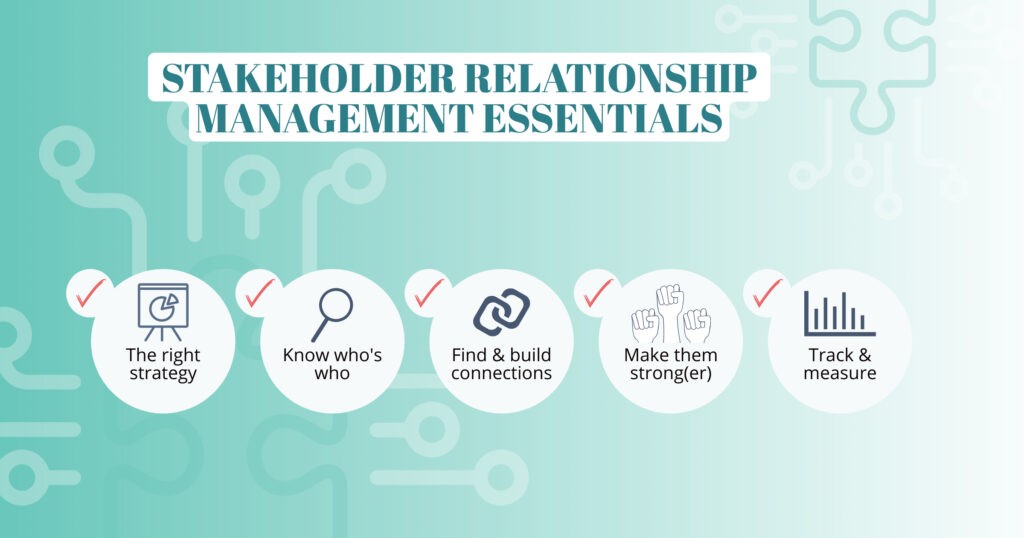What is Stakeholder Relationship Management?

Heard about stakeholder relationship management and curious about what it’s all about? Or perhaps you’re a project manager or leader who’s discovered this in your role description…
We’ve got you covered! Discover what stakeholder relationship management really is, why it matters, tools to support the process, and all the essentials to successfully manage your stakeholder relationships.
Defining Stakeholder Relationship Management

Stakeholder relationship management is often one part of stakeholder management, stakeholder engagement, or public consultation — with one obvious-but-important distinction. It focuses on managing the relationships with stakeholders. This means:
- Strategically connecting with new stakeholders
- Strengthening existing relationships
- Building connections between stakeholders and groups
- Monitoring and evaluating those relationships
Why Stakeholder Relationship Management Matters
Quite simply, healthy relationships with the right people can add a whole lot of value to your organization or project. So much so, that it’s worth taking a strategic approach to building and maintaining those relationships.
Managing relationships is an important part of managing projects. After all, many people need to work together closely in order to make a project happen. Stakeholder relationships can allow you to cooperate, share knowledge and resources, build mutual understanding, work through conflicts, and much more.
And relationships are just as important in consultation or engagement — strong relationships with the right individuals or community groups can carry you through, even when you’re in the midst of a crisis or you’re facing a lot of resistance.
To sum it up: people and relationships are central to everything you do. And if they’re not… you might just be doing it wrong.
Stakeholder Relationship Management Essentials

Here are a few basics of successful stakeholder relationship management:
Getting the Strategy Right
Before you dive in too deep, it’s important to lay some foundations. There’s gotta be some clear reasons for managing your stakeholder relationships. We’ve already mentioned a few potential ways this process can benefit you, but think carefully about the goals and objectives you want to achieve from stakeholder relationship management. It’s not necessarily an easy or fast process to go through, so these will help you stay the course — and ensure that you use your time more effectively.
At this point, you might want to open up a stakeholder management plan so that you can note your goals down there (leaving space to add stakeholder analysis, strategies, and activities — these are coming up next).
By the way, you might want to check out some other posts we’ve written on this topic, including How to Strategically Manage Your Stakeholder Relationships, How to Create a Business Relationship Management Strategy & 10 Stakeholder Engagement Objectives.
Knowing Who’s Who
The first thing you need to know is that these days, nearly everyone is a potential stakeholder. In other words, any individual or group may take an interest in your project or organization. Of course, a much smaller number will experience direct impacts from your project, or be able to exert any influence on it. But keep this in mind when coming up with a list of potential stakeholders.
From there, you’ll need to get to know this list a lot better. Dive into our content on Stakeholder Analysis and Stakeholder Mapping — you’ll find everything you need to know there. In particular, take a look at Stakeholder Relationship Networks — this method of visualizing stakeholder relationships can be really handy. These approaches will allow you to really know who’s who from your list, and figure out who your key stakeholders are.
Finding & Building Connections
Finding your stakeholders will depend on many different factors. If your project is locally based, you may be able to find residential and business addresses to send letters to, or you may choose to go door knocking. In other cases, you might attend local business networking, conferences, community events, or some other event where your stakeholders are likely to gather. You might hold a stall at a local market or sponsor the newsletter for a school. You might find a collaborative partner that’s well established who can put you in all the right places. And you might even connect with some of your stakeholders online via advertising, organic social media, or even connections on LinkedIn.
Think creatively about where you might find your stakeholders and go there. Once you’re introduced to enough stakeholders, it’ll be easier to build momentum because the people you know will introduce you to the people they know.
For more insights, check out our blog on Forming Relationships with Stakeholders: How the Pros Do It.
Making Them Strong(er)
Once you’re connected with someone, don’t take a passive approach towards the relationship (especially if they’re a key stakeholder). Here are some things you can do to actively strengthen your relationships:
- Be transparent – This is critical in order to build authentic stakeholder relationships
- Provide value – If you’ve got something of value (information, resources, connections, time) then share it with your stakeholders
- Build social capital –
- Manage expectations – Communicate what you’ll deliver, when, and how you’ll deliver it
- Be targeted – Different stakeholders require different approaches (messages, platforms, and methods)
- Encourage participation – If stakeholders are willing, involve them in your project through feedback, focus groups, decision-making, and other genuine opportunities to participate
- Think long-term – Your most valuable and productive relationships will likely be years long and span multiple engagements and projects
Want to read more on what goes into strengthening stakeholder relationships? Check out our blogs on How to Build Strategic Relationships Inside (and Outside) Of Your Organization and Business Relationship Management: Best Practices for Success.
Tracking & Measuring Stakeholder Relationships
Unlike other stakeholder attributes, such as impact, interest, and influence, stakeholder relationships can be trickier to track, measure, and record.
Stakeholder relationships are also dynamic and volatile. What your stakeholders want, how they feel towards your project, what their goals are, their interests, their actions, and who they’re connected to — can all change at any moment.
So, what’s the best approach?
Ideally, you should seek out stakeholder relationship management software that allows you to record any important data about your relationships (and easily update it). Useful data and features to look for could include:
- Stakeholder contact records
- Stakeholder sentiment
- Interest/Impact/Interest analysis
- Qualitative data analysis
- Communication & conversation records
- Relationships between internal staff and stakeholders
- Relationships between various stakeholder groups
- Relationship scoring
- Segmentation
- Reporting
Stakeholder Relationship Management Tools

The good news is there are many tools out there to help you manage stakeholder relationships.
We’ve talked about various tools that can support the stakeholder management process, such as stakeholder diagrams, stakeholder mapping, relationship mapping, and stakeholder relationship network mapping.
And of course, there’s relationship management software. Simply Stakeholders has caught your eye as a top candidate that outperforms CRMs and spreadsheets when it comes to managing stakeholder relationships. We’ve recently added more functionality in this space, including relationship network maps (and there’s more to come). Read more about this in our blogs:
- What is Relationship Intelligence Software?
- The Benefits of Relationship Management Software
- Time to Upgrade Your CRM to Enterprise Relationship Management Software?
- Can Hubspot be used for Stakeholder Relationship Management?
- Corporate Relationship Management: When Asana & Spreadsheets Don’t Cut It Anymore
If you want to learn more about how you can manage stakeholder relationships with Simply Stakeholders, contact us for a demo.



































